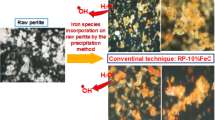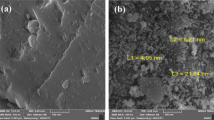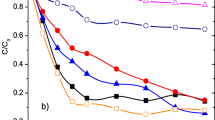Abstract
Herein, the catalytic activity of two types of iron-loaded perlite catalysts prepared by impregnation of raw and calcined perlite in terms of 8-hydroxyquinoline-5-sulfonic acid (8-HQS) degradation was investigated by the Fenton reaction. Different iron contents were used to optimize the Fenton catalytic reaction. The as-prepared catalysts were characterized using different spectrophotometry techniques. The effect of some operating parameters on the Fenton oxidation of 8-HQS was carried out. Iron content of 10% has led to the highest catalytic efficiency. Furthermore, the oxidation of 8-HQS is highly affected by the addition of H2O2, proposing that the heterogeneous Fenton reaction has been successfully activated. Whatever the type of the used catalyst, the heterogeneous catalytic oxidation process is extremely rapid, even instantaneous. The synthesized catalysts remained potentially active and retained their catalytic activity for successive Fenton reactions suggesting their economic benefit over the homogenous Fenton process. Accordingly, the newly prepared heterogeneous solid could be successfully used to treat wastewater effluents containing persistent organic compounds.
Graphical abstract














Similar content being viewed by others
Data availability
Not applicable.
References
Ahmed IM, Attia LA, Attallah MF (2020) Modification of perlite to prepare low cost zeolite as adsorbent material for removal of 144Ce and 152+154Eu from aqueous solution. Radiochim Acta 108:727–735
Babuponnusami A, Muthukumar K (2014) A review on Fenton and improvements to the Fenton process for wastewater treatment. J Environ Chem Eng 2:557–572
Bagdassarov N, Ritter, Yanev Y (1999) Kinetics of perlites degassing: TG and DSC analysis. Glass Sci Technol-Frankfurt am Main- 72:277–290
Baloyi J, Ntho T, Moma J (2018) Synthesis and application of pillared clay heterogeneous catalysts for wastewater treatment: a review. RSC Adv 8:5197–5211
Bautista P, Mohedano AF, Casas JA, Zazo JA, Rodriguez JJ (2008) An overview of the application of Fenton oxidation to industrial wastewaters treatment. J Chem Technol Biotechnol 83:1323–1338
Boddu VM, Hay KJ, Ghosh TK, Viswanath DS (2009) Method for surface treating perlite sorbents for improved adsorbing of vapor phase metals and metal compounds at elevated temperatures. US7524794B2
Brindha K, Amutha P, Krishnakumar B, do Nascimento Sobral AJF (2019) BiCl3-modified perlite as an effective catalyst for selective organic transformations: a green protocol. Res Chem Intermed 45:4367–4381
Briton BGH, Duclaux L, Richardson Y, Yao KB, Reinert L, Soneda Y (2019) Effectiveness of the dispersion of iron nanoparticles within micropores and mesopores of activated carbon for Rhodamine B removal in wastewater by the heterogeneous Fenton process. Appl Water Sci 9:166. https://doi.org/10.1007/s13201-019-1047-0
Buthiyappan A, Abdul Aziz AR, Wan Daud WMA (2016) Recent advances and prospects of catalytic advanced oxidation process in treating textile effluents. Rev Chem Eng 32:1–47
Carbajo J, Silveira JE, Pliego G, Zazo JA, Casas JA (2021) Increasing Photo-Fenton process Efficiency: the effect of high temperatures. Sep Purif Technol 271:118876. https://doi.org/10.1016/j.seppur.2021.118876
Dapaah MF, Niu Q, Yu Y-Y, You T, Liu B, Cheng L (2022) Efficient persistent organic pollutant removal in water using MIL-metal–organic framework driven Fenton-like reactions: a critical review. Chem Eng J 431:134182
Deng J, Dong H, Zhang C, Jiang Z, Cheng Y, Hou K, Zhang L, Fan C (2018) Nanoscale zero-valent iron/biochar composite as an activator for Fenton-like removal of sulfamethazine. Sep Purif Technol 202:130–137
Du C, Zhang Y, Zhang Z, Zhou L, Yu G, Wen X, Chi T, Wang G, Su Y, Deng F (2022) Fe-based metal organic frameworks (Fe-MOFs) for organic pollutants removal via photo-Fenton: a review. Chem Eng J 431:133932
Esmaielpour M, Akhlaghinia B, Jahanshahi R (2017) Green and efficient synthesis of aryl/alkylbis(indolyl)methanes using expanded perlite-PPA as a heterogeneous solid acid catalyst in aqueous media. J Chem Sci 129:313–328
Fontecha-Cámara MA, Álvarez-Merino MA, Carrasco-Marín F, López-Ramón MV, Moreno-Castilla C (2011) Heterogeneous and homogeneous Fenton processes using activated carbon for the removal of the herbicide amitrole from water. Appl Catal B 101:425–430
Grčić I, Obradović M, Vujević D, Koprivanac N (2010) Sono-Fenton oxidation of formic acid/formate ions in an aqueous solution: from an experimental design to the mechanistic modeling. Chem Eng J 164:196–207
Hamdi N, Proietto F, Ben Amor H, Galia A, Inguanta R, Ammar S, Gadri A, Scialdone O (2020) Effective removal and mineralization of 8-hydroxyquinoline-5-sulfonic acid through a pressurized electro-Fenton-like process with Ni−Cu−Al layered double hydroxide. ChemElectroChem 7:2457–2465
Hartmann M, Kullmann S, Keller H (2010) Wastewater treatment with heterogeneous Fenton-type catalysts based on porous materials. J Mater Chem 20(41):9002. https://doi.org/10.1039/c0jm00577k
Herney-Ramirez J, Lampinen M, Vicente MA, Costa CA, Madeira LM (2008) Experimental design to optimize the oxidation of Orange II dye solution using a clay-based Fenton-like catalyst. Ind Eng Chem Res 47:284–294
Herney-Ramírez J, Madeira LM (2010): Use of Pillared clay-based catalysts for wastewater treatment through Fenton-like processes. Pillared Clays and Related Catalysts pp 129–165. https://doi.org/10.1007/978-1-4419-6670-4_6
Jahanshahi R, Akhlaghinia B (2015) Expanded perlite: an inexpensive natural efficient heterogeneous catalyst for the green and highly accelerated solvent-free synthesis of 5-substituted-1H-tetrazoles using [bmim]N3 and nitriles. RSC Adv 5:104087–104094
Jiang L, Wang J, Wu X, Zhang G (2017) A stable Fe2O3/expanded perlite composite catalyst for degradation of rhodamine B in heterogeneous photo-Fenton system. Water Air Soil Pollut 228:12 . https://doi.org/10.1007/s11270-017-3646-4
Jiao C, Ji B, Fang D (2012) Preparation and properties of lauric acid–stearic acid/expanded perlite composite as phase change materials for thermal energy storage. Mater Lett 67:352–354
Joseph J, Iftekhar S, Srivastava V, Fallah Z, Zare EN, Sillanpaa M (2021) Iron-based metal-organic framework: Synthesis, structure and current technologies for water reclamation with deep insight into framework integrity. Chemosphere 284:131171
Khudr MS, Ibrahim YME, Garforth A, Alfutimie A (2021) On copper removal from aquatic media using simultaneous and sequential iron-perlite composites. J Water Proc Eng 40:101842. https://doi.org/10.1016/j.jwpe.2020.101842
Kolvari E, Koukabi N, Hosseini MM, Khandani Z (2015) Perlite: an inexpensive natural support for heterogenization of HBF4. RSC Adv 5:36828–36836
Liao CH, Kang SF, Wu FA (2001) Hydroxyl radical scavenging role of chloride and bicarbonate ions in the H2O2/UV process. Chemosphere 44:1193–1200
Maryami M, Nasrollahzadeh M, Mehdipour E, Sajadi SM (2017) Green synthesis of the Pd/perlite nanocomposite using Euphorbia neriifolia L. leaf extract and evaluation of its catalytic activity. Sep Purif Technol 184:298–307
Michael I, Hapeshi E, Michael C, Fatta-Kassinos D (2010) Solar Fenton and solar TiO2 catalytic treatment of ofloxacin in secondary treated effluents: evaluation of operational and kinetic parameters. Water Res 44:5450–5462
Mirzaei A, Chen Z, Haghighat F, Yerushalmi L (2017) Removal of pharmaceuticals from water by homo/heterogonous Fenton-type processes - a review. Chemosphere 174:665–688
Navalon S, Alvaro M, Garcia H (2010) Heterogeneous Fenton catalysts based on clays, silicas and zeolites. Appl Catal B 99:1–26
Navalon S, Dhakshinamoorthy A, Alvaro M, Garcia H (2011) Heterogeneous fenton catalysts based on activated carbon and related materials. Chemsuschem 4:1712–1730
Papa E, Medri V, Natali Murri A, Laghi L, De Aloysio G, Bandini S, Landi E (2018) Characterization of alkali bonded expanded perlite. Constr Build Mater 191:1139–1147
Poza-Nogueiras V, Arellano M, Rosales E, Pazos M, Sanromán MA, González-Romero E (2018) Electroanalytical techniques applied to monitoring the electro-Fenton degradation of aromatic imidazolium-based ionic liquids. J Appl Electrochem 48:1331–1341
Puga A, Rosales E, Pazos M, Sanromán MA (2020) Prompt removal of antibiotic by adsorption/electro-Fenton degradation using an iron-doped perlite as heterogeneous catalyst. Process Saf Environ Prot 144:100–110
Ramirez JH, Maldonado-Hódar FJ, Pérez-Cadenas AF, Moreno-Castilla C, Costa CA, Madeira LM (2007) Azo-dye Orange II degradation by heterogeneous Fenton-like reaction using carbon-Fe catalysts. Appl Catal B 75:312–323
Roulia M, Chassapis K, Kapoutsis JA, Kamitsos EI, Savvidis T (2006) Influence of thermal treatment on the water release and the glassy structure of perlite. J Mater Sci 41:5870–5881
Sassi H, Lafaye G, Ben Amor H, Gannouni A, Jeday MR, Barbier J (2017) Wastewater treatment by catalytic wet air oxidation process over Al-Fe pillared clays synthesized using microwave irradiation. Front Environ Sci Eng 12:2. https://doi.org/10.1007/s11783-017-0971-1
Saufi H, El Alouani M, Alehyen S, El Achouri M, Aride J, Taibi Mh (2020) Photocatalytic degradation of methylene blue from aqueous medium onto perlite-based geopolymer. Int J Chem Eng 2020:1–7
Shavisi Y, Sharifnia S, Hosseini SN, Khadivi MA (2014) Application of TiO2/perlite photocatalysis for degradation of ammonia in wastewater. J Ind Eng Chem 20:278–283
Soufi A, Hajjaoui H, Elmoubarki R, Abdennouri M, Qourzal S, Barka N (2021) Spinel ferrites nanoparticles: synthesis methods and application in heterogeneous Fenton oxidation of organic pollutants – a review. Appl Surf Sci Adv 6:100145
Tekin H, Bilkay O, Ataberk SS, Balta TH, Ceribasi IH, Sanin FD, Dilek FB, Yetis U (2006) Use of Fenton oxidation to improve the biodegradability of a pharmaceutical wastewater. J Hazard Mater 136:258–265
Trabelsi S (2011) Etudes de traitement des lixiviats des déchets urbains par les procédés d’oxydation avancée photochimiques et électrochimiques: application aux lixiviats de la décharge tunisienne ”Jebel Chakir”. Sciences de la Terre, Université Paris-Est Français. NNT: 2011PEST1122
Wang F-X, Wang C-C, Du X, Li Y, Wang F, Wang P (2022) Efficient removal of emerging organic contaminants via photo-Fenton process over micron-sized Fe-MOF sheet. Chem Eng J 429:132495. https://doi.org/10.1016/j.cej.2021.132495
Wang N, Zheng T, Zhang G, Wang P (2016) A review on Fenton-like processes for organic wastewater treatment. J Environ Chem Eng 4:762–787
Wang S (2008) A comparative study of Fenton and Fenton-like reaction kinetics in decolourisation of wastewater. Dyes Pigm 76:714–720
Wang Y, Sun Y, Li W, Tian W, Irini A (2015) High performance of nanoscaled Fe2O3 catalyzing UV-Fenton under neutral condition with a low stoichiometry of H2O2: Kinetic study and mechanism. Chem Eng J 267:1–8
Xu M, Wu C, Zhou Y (2020) Advancements in the Fenton process for wastewater treatment. Advanced Oxidation Processes, Applications, Trends, and Prospects 61. https://doi.org/10.5772/intechopen.90256
Yao H, **e Y, **g Y, Wang Y, Luo G (2017) Controllable preparation and catalytic performance of heterogeneous Fenton-like α-Fe2O3/crystalline glass microsphere catalysts. Ind Eng Chem Res 56:13751–13759
Zhang H, Fu H, Zhang D (2009) Degradation of C.I. Acid Orange 7 by ultrasound enhanced heterogeneous Fenton-like process. J Hazard Mater 172:654–660
Zhang MH, Dong H, Zhao L, Wang DX, Meng D (2019) A review on Fenton process for organic wastewater treatment based on optimization perspective. Sci Total Environ 670:110–121
Acknowledgements
The authors acknowledge Professor Hassen Abdallah from the Energy Research and Technology Center (CRTEn, Hammam-Lif, Tunisia) for providing the digital processing units used to perform the microscopic image observation.
Funding
The authors received financial support from the Ministry of Higher Education (TUNISIA).
Author information
Authors and Affiliations
Contributions
All the authors contributed to the experimental study performed in the Laboratory of Wind Energy Control and Waste Energy Management (LMEEVED) (CRTEn). Material preparation, data collection and analysis were performed by BOUMNIJEL Ibtissem, HACHEM Houda, HAMDI Najwa, BEN AMOR Hedi and MIHOUBI Daoued. The first draft of the manuscript was written by BOUMNIJEL Ibtissem, and all the authors commented on previous versions of the manuscript. All the authors read and approved the final manuscript.
Corresponding author
Ethics declarations
Ethics approval
This article does not contain any studies with human participants or animals performed by any of the authors.
Consent to participate
All authors are aware of and accept responsibility for the manuscript.
Consent for publication
No part of the manuscript contents has been published or has been accepted for publication elsewhere.
Conflict of interest
The authors declare no competing interests.
Additional information
Responsible Editor: Ricardo A. Torres-Palma
Publisher's note
Springer Nature remains neutral with regard to jurisdictional claims in published maps and institutional affiliations.
Rights and permissions
Springer Nature or its licensor holds exclusive rights to this article under a publishing agreement with the author(s) or other rightsholder(s); author self-archiving of the accepted manuscript version of this article is solely governed by the terms of such publishing agreement and applicable law.
About this article
Cite this article
Boumnijel, I., Hamdi, N., Hachem, H. et al. Fenton oxidation catalysed by heterogeneous iron–perlite for 8-hydroxyquinoline-5-sulfonic acid (8-HQS) degradation: efficiency comparison using raw and calcined perlite as precursors for iron fixation. Environ Sci Pollut Res 30, 6201–6215 (2023). https://doi.org/10.1007/s11356-022-22619-3
Received:
Accepted:
Published:
Issue Date:
DOI: https://doi.org/10.1007/s11356-022-22619-3




